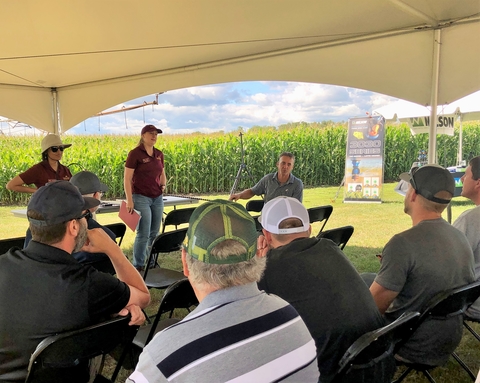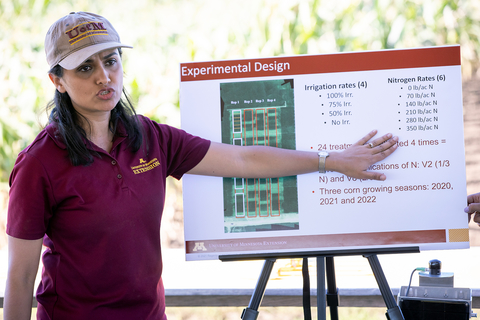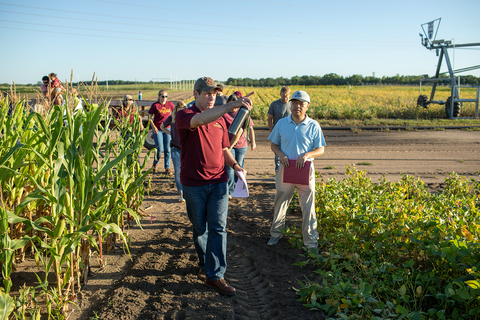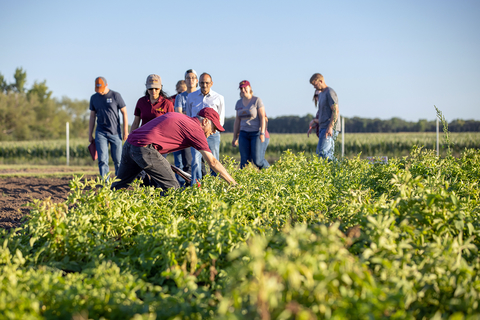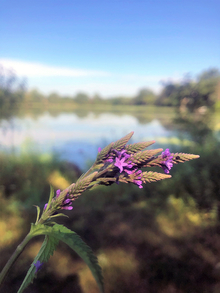Irrigating for quality crops while conserving water requires technology and the knowledge that powers it.
Farmers are in it for the long haul, six generations deep in the case of Grant Anderson and family of Belgrade.
The Anderson farm in the Bonanza Valley sits on a sand plain that reaches out from the shores of the Mississippi River.
The speed with which water drains through sandy soils makes watering crops in a sand plain both an agronomic necessity and a conservation challenge.
Testing technology
Vasudha Sharma, University of Minnesota Extension irrigation specialist, addresses this need for balance in the sand plain through research, collaboration with innovative agricultural equipment companies and a lot of engagement.
Sharma’s current research focuses on variable rate irrigation, which involves using sensors deep in the ground to detect and communicate water availability and other data. She is testing sensors from a company called EarthScout at the Anderson farm as a complement to the research conducted at dedicated crop research plots.
A day on the Anderson family’s farm
Grant Anderson’s family was on the team that developed the Bonanza Valley Groundwater Management Area plan, and he serves on the Agricultural Fertilizer Research and Education Council (AFREC).
Not only does Anderson understand the issues – and even his young son listens in as he discusses them – but Anderson tells participants at an educational field day hosted on the family farm about variable rate irrigation from his own perspective.
“With my farmer hat on, I’m ready to push the [irrigation system] button when I go by and see the corn on the hilltop curling up a little bit, and I see that the next three days are 90 degrees and sunny,” Anderson tells the visitors. “But with the help of Vasudha, combined with other data and seven-day forecasts, we will save on irrigation expense and use precisely the amount of water that we need.”
Studying nutrients and water together
Nitrogen fertilizer and water are related; it makes sense to study them together to learn how to have a profitable crop while conserving water and reducing environmental impact.
Fabián Fernández, Extension nutrient management specialist, has studied irrigation timing and nitrogen sources, and conducts long-term studies (10-15 years) that result in recommendations capable of producing real savings for farmers.
One of those recommendations has been to focus more on split fertilizer applications during the growing season instead of a single application before planting. It gets more specific from there, depending on many factors.
“Sandy soils are not a good nitrogen savings account,” says Fernández. “Don’t put your nitrogen there and expect it to be there later.”
Partners in soil and water conservation
Miranda Wagner is one of the many devoted professionals with Minnesota’s Soil and Water Conservation Districts (SWCDs) who attended a recent Extension field day at the University’s Sand Plain Research Farm in Becker.
“The topics relate directly to many of the operators I work with,” says Wagner. “Working in the sands — and the balance of water and nitrogen — is at the root of many of the conservation practices on Sherburne County’s working lands.”
SWCDs and the University of Minnesota have been working together on research and education for sandy soils since at least 1968, when Pope, Kandiyohi and Stearns counties’ SWCDs purchased the Rosholt Farm in Westport, Minn. It’s another site where Sharma’s irrigation studies complement Fernandez’s research on nitrate leaching.
By conducting research and education in both dedicated research plots and on family farms, Extension ensures that recommendations are based in science and practicality.
“The most important thing in my Extension role is to give this knowledge that we learned from research to the end users, the decision-makers on the farm,” says Sharma. “I work with growers to see how this research plays out on real working farms, and so they understand it firsthand.”
Sandy soils 101
- Rocks, gravel and sand wash out to shore from the edges of fast-running rivers, which were created from the melting ice of receding glaciers.
- These outwash areas have a spectrum of sandy to loamy textured soils. Sand drains and has no organic matter or nutrients. Loamier sands hold water better.
- Minnesota outwash areas include the Anoka Sand Plain, North Central Sands and the Bonanza Valley; a variety of crops grow in these regions with careful management.
- Potatoes and other root vegetables grow well in sandy soils, and Minnesota is a top producer of red potatoes. Decisions on potato variety, nutrient management and irrigation are keys to a high-quality harvest.
Did you know?
The Minnesota Association of Soil and Water Conservation Districts (MASWCD) has operated a leadership institute facilitated by Extension educators since 1996.
“Participants build proficiency in such critical areas as communication, team building and visionary leadership that provide them with the skills to do effective conservation work across Minnesota,” says LeAnn Buck, MASWCD executive director.
Permission is granted to news media to republish our news articles with credit to University of Minnesota Extension. Images also may be republished; please check for specific photographer credits or limited use restrictions in the photo title.


